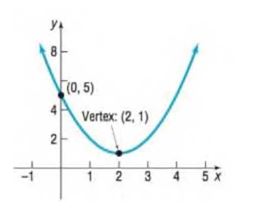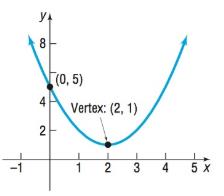
In Problems 49-54, determine the quadratic function whose graph is given.

To calculate: The quadratic function using the given graphs.
Answer to Problem 48AYU
The equation of the given graph is .
Explanation of Solution
Given:
The given graph is

Formula Used:
The general form of a quadratic equation is .
This general equation can also be written as , where
If , the graph opens upwards.
If , the graph opens downwards.
The vertex of the above function is
The axis of symmetry will be .
We can find the by equating the equation at .
We can find the by equation the equation at .
1. If then the vertex is the .
2. If then the graph has no .
3. If then the vertex is the .
Calculation:
Here, we can see that the graph is open upwards. Therefore, we get .
The vertex of the given graph is at .
Thus, we have
Therefore, the equation of the given graph is
Now, we have to determine the value of .
From the given graph, we can see that the
From the given graph, we can see that the is at .
Therefore, we have
Therefore, we get .
Thus, the equation of the given graph is
The equation is .
Chapter 3 Solutions
Precalculus
Additional Math Textbook Solutions
Elementary Statistics (13th Edition)
College Algebra (7th Edition)
Basic Business Statistics, Student Value Edition
Pre-Algebra Student Edition
Calculus: Early Transcendentals (2nd Edition)
University Calculus: Early Transcendentals (4th Edition)
- Let the region R be the area enclosed by the function f(x)= = 3x² and g(x) = 4x. If the region R is the base of a solid such that each cross section perpendicular to the x-axis is an isosceles right triangle with a leg in the region R, find the volume of the solid. You may use a calculator and round to the nearest thousandth. y 11 10 9 00 8 7 9 5 4 3 2 1 -1 -1 x 1 2arrow_forwardLet the region R be the area enclosed by the function f(x) = ex — 1, the horizontal line y = -4 and the vertical lines x = 0 and x = 3. Find the volume of the solid generated when the region R is revolved about the line y = -4. You may use a calculator and round to the nearest thousandth. 20 15 10 5 y I I I | I + -1.5 -1 -0.5 0.5 1 1.5 2 2.5 3 -5 I -10 -15 I + I I T I I + -20 I + -25 I I I -30 I 3.5 4 xarrow_forwardplease show all the workarrow_forward
 Calculus: Early TranscendentalsCalculusISBN:9781285741550Author:James StewartPublisher:Cengage Learning
Calculus: Early TranscendentalsCalculusISBN:9781285741550Author:James StewartPublisher:Cengage Learning Thomas' Calculus (14th Edition)CalculusISBN:9780134438986Author:Joel R. Hass, Christopher E. Heil, Maurice D. WeirPublisher:PEARSON
Thomas' Calculus (14th Edition)CalculusISBN:9780134438986Author:Joel R. Hass, Christopher E. Heil, Maurice D. WeirPublisher:PEARSON Calculus: Early Transcendentals (3rd Edition)CalculusISBN:9780134763644Author:William L. Briggs, Lyle Cochran, Bernard Gillett, Eric SchulzPublisher:PEARSON
Calculus: Early Transcendentals (3rd Edition)CalculusISBN:9780134763644Author:William L. Briggs, Lyle Cochran, Bernard Gillett, Eric SchulzPublisher:PEARSON Calculus: Early TranscendentalsCalculusISBN:9781319050740Author:Jon Rogawski, Colin Adams, Robert FranzosaPublisher:W. H. Freeman
Calculus: Early TranscendentalsCalculusISBN:9781319050740Author:Jon Rogawski, Colin Adams, Robert FranzosaPublisher:W. H. Freeman
 Calculus: Early Transcendental FunctionsCalculusISBN:9781337552516Author:Ron Larson, Bruce H. EdwardsPublisher:Cengage Learning
Calculus: Early Transcendental FunctionsCalculusISBN:9781337552516Author:Ron Larson, Bruce H. EdwardsPublisher:Cengage Learning





